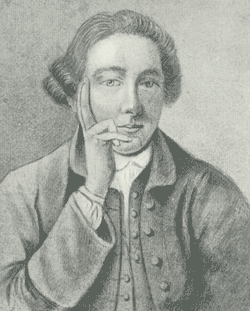Thomas Chambars, Engraver
(b. about 1724, d. 1789)
Engraver
From A Dictionary of Irish Artists 1913

Thomas Chambars. Chalk drawing; in British Museum.
Was born in London, of Irish parentage, about 1724. His parents appear to have returned to Ireland, as he studied in the Dublin Society's School in George's Lane, and was in practice in Dublin as an engraver as early as 1746, the date of his print of "Mary Gore, aged 103." Chaloner Smith notes ("British Mezzotint Portraits," p. 1708), that there is a copy, in reverse, of Andrew Miller's mezzotint of Swift (C.S. 52), published by J. Orpin in Crane Lane, on which, in the only impression known to him, the engraver's name had been nearly obliterated but might be T. Chambars fecit. If this be so it would go to show that Chambars learned mezzotint from Miller, though he did not afterwards work in that method but confined himself to line engraving.
In Walter Harris's "Life and Reign of William III," published in 1749, are two plates of medals by him; and he also engraved Tudor's "View of the Fire-works in Stephen's Green," published in March, 1749. A head of Charles Lucas engraved by him appears on the title-page of "The Great Charter of the Liberties of the City of Dublin," by Lucas, published by James Esdall in 1749. In Smith's "History of Cork" are three plates, T. Chambars Sculpt. Dublin 1750. Before 1757 Chambars had gone to London, as in that year an edition of Smollet's "History of England" appeared with plates by him. He engraved many of the portraits in Walpole's "Anecdotes of Painting," and did several large plates for Boydell and sometimes worked in conjunction with Grignion, A "Portrait of Augusta Goldney," ad vivum, was prefixed to her father, Edward Goldney's "Epistle to the Deists," 1759.
In 1765 he was awarded a premium of forty guineas by the Society of Arts for an engraving of "A Concert," after Caravaggio; and in 1766, when he was in France, a premium of the same amount for "A Spanish Collation," after Van Harp. He was an exhibitor with the Society of Artists from 1761 to 1768, and was elected a Fellow of that body. In 1770 he was elected an Associate-Engraver of the Royal Academy, but his only appearance there as an exhibitor was in 1773 when he sent his print of "St. Agnes." In 1766 he sent over to the Society of Artists in Dublin two prints, one after Rubens and one after Raphael.
Chambars was an able and vigorous engraver, but although he seems to have found ample employment for his graver he was not successful in making a living. He fell into distress, and one day being importuned for the rent of his lodgings he went out leaving on his table a note for his landlord: "If I do not return by to-morrow night I desire you will sell my effects and pay yourself." Some days afterwards his body was found in the Thames near Battersea. According to Redgrave this was in 1789; but Whitelaw and Walsh ("History of Dublin," II, p. 1182) give the year of his death as 1792. Besides the works already mentioned Chambars engraved the following plates:
Jupiter and Antiope; after Andrea Sacchi, 1762.
A Concert; after Caravaggio, 1764; considered his best work; awarded a premium by the Society of Arts in 1765.
St. Martin dividing his Cloak; after Rubens, 1766.
SS. Peter and John healing the Sick; after S. Bourdon, 1767.
Diana and Endymion; after Trevisani, 1768.
Mrs. Quarrington as St. Agnes; after Sir J. Reynolds, 1787.
Magdalen; after Raphael.
Helena Forman; after Van Dyck.
Holy Family; after Murillo.
Miss Conyers; after Devis.
Chevalier D'Eon; after Cosway, 1787.
The Good Man at the Hour of Death; after F. Hayman.
The Wicked Man at the Hour of Death; after F. Hayman.
Views in Smith's History of Cork, 1750, viz.:
East Prospect of Youghal; after A. Chearnley.
Prospect of Kingsale; after A. Chearnley.
View of the City of Cork; after A. Chearnley.
« William Chalmers | Contents and Search | George Chancellor »
